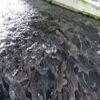The cauliflower inflorescence is a highly modified floral structure. Unlike typical flowers, the cauliflower curd is an arrested stage of floral development, meaning the buds do not fully develop into flowers. This arrested development results in the dense, white, and compact structure known as the curd.
The formation of the inflorescence begins with the apical meristem, a region of actively dividing cells at the tip of the plant. In cauliflower, genetic regulation causes the meristem to proliferate without differentiating into individual flowers, leading to the formation of the curd.
The inflorescence comprises numerous undeveloped floral buds. These buds are packed tightly together and covered by modified leaves called bracts. The dense packing of buds gives the cauliflower its characteristic appearance.
The white color of the curd is due to the lack of chlorophyll, a pigment essential for photosynthesis, as the curd develops away from direct sunlight, often shielded by the plant’s leaves. Some cauliflower varieties, however, may have different colors such as green, purple, or orange, due to varying levels of pigments like anthocyanins and carotenoids.
From a botanical perspective, the cauliflower inflorescence is classified as a compound raceme. This classification means that the primary stem (peduncle) branches into several smaller stems (pedicels), each ending in a flower bud. In cauliflower, these flower buds remain underdeveloped. The genetic pathways that control this developmental arrest are a subject of extensive research, as they hold the key to understanding not only cauliflower morphology but also the evolution and domestication of this and related crops.
Nutritionally, the cauliflower inflorescence is rich in vitamins, minerals, and dietary fiber. It contains significant amounts of vitamin C, vitamin K, folate, and several B vitamins. It is also a good source of antioxidants, including glucosinolates and isothiocyanates, compounds that have been studied for their potential anti-cancer properties. The low-calorie content and high nutrient density make cauliflower a valuable component of a healthy diet.
Agronomically, the quality of the cauliflower inflorescence is a critical factor in its marketability. Factors such as curd size, color, firmness, and the absence of defects like browning or riciness (where the buds start to separate) are important quality indicators.
Growers must manage environmental conditions, including temperature, soil quality, and water supply, to ensure optimal inflorescence development. Pests and diseases can also affect the quality of the inflorescence, making integrated pest management strategies essential for successful cultivation.
The cauliflower inflorescence is also of significant interest in plant breeding. Breeders aim to develop varieties with desirable traits such as improved curd quality, resistance to pests and diseases, and adaptability to different growing conditions. Advances in genetic engineering and biotechnology offer new possibilities for enhancing these traits, potentially leading to more resilient and productive cauliflower varieties.
In conclusion, the cauliflower inflorescence is a fascinating botanical structure with complex developmental biology. Its unique morphology results from arrested floral development, leading to the formation of the dense, edible curd.
Understanding the scientific aspects of cauliflower inflorescence enhances our knowledge of plant development and offers insights into improving agricultural practices and crop breeding. As a nutritious and versatile vegetable, the cauliflower inflorescence continues to be a vital part of global diets and agricultural systems.
Cauliflower Inflorescence: Economic Importance and Uses

The cauliflower inflorescence, also known as the curd, is the most commercially valuable part of the cauliflower plant (Brassica oleracea var. botrytis). This dense, edible head is a product of arrested floral development and is highly prized for its nutritional value, versatility in cooking, and economic importance. Below are 18 economic importance and uses of cauliflower inflorescence:
1. Nutritional Value: Cauliflower inflorescence is rich in vitamins (C, K, B6), minerals (folate, potassium), and dietary fiber, making it a nutritious addition to diets globally.
2. Culinary Versatility: The inflorescence can be consumed raw, steamed, roasted, grilled, or blended, making it a versatile ingredient in various dishes.
3. Low-Calorie Food: With its low-calorie content, cauliflower inflorescence is popular among health-conscious consumers and those aiming for weight management.
4. Antioxidant Source: Contains antioxidants such as glucosinolates and isothiocyanates, which have been linked to reduced cancer risk.
5. Gluten-Free Substitute: Often used as a substitute for gluten-containing foods, such as in cauliflower rice, pizza crust, and mashed cauliflower.
6. Economic Crop: A high-yielding crop that provides significant income for farmers, especially in regions where it is a staple vegetable.
7. Export Commodity: Major export product for countries like China and India, contributing to their agricultural exports.
8. Industrial Use: Processed into cauliflower powder for use in soups, sauces, and dietary supplements.
9. Food Processing: Used in frozen and canned vegetable mixes, extending its shelf life and availability.
10. Specialty Diets: Integral part of keto, paleo, and vegan diets due to its versatility and nutritional profile.
11. Functional Food Ingredient: Added to various food products to enhance nutritional value and health benefits.
12. Agricultural Rotation Crop: Improves soil health and reduces pest populations when used in crop rotation systems.
13. By-Product Utilization: Stalks and leaves can be used as animal feed, reducing waste and providing economic value.
14. Organic Farming: Cauliflower inflorescence is a popular crop in organic farming, fetching higher market prices.
15. Value-Added Products: Used to create value-added products such as cauliflower chips and snacks.
16. Research and Development: Subject of agricultural research aimed at improving yield, pest resistance, and nutritional content.
17. Culinary Innovation: Featured in gourmet and innovative culinary creations, enhancing its market appeal.
18. Seasonal Employment: Provides seasonal employment opportunities in farming and processing sectors.
Read Also: Health Benefits and Side Effects of Opium Poppy (Papaver Somniferum)
Products and By-products That Can Be Derived From Cauliflower Inflorescence

1. Fresh Cauliflower: The primary product sold in markets for direct consumption.
2. Cauliflower Rice: Made by finely chopping or grating the inflorescence, used as a low-carb substitute for rice.
3. Cauliflower Flour: Ground inflorescence used as a gluten-free flour alternative.
4. Cauliflower Pizza Crust: Made by mixing processed inflorescence with binding agents, offering a low-carb pizza option.
5. Frozen Cauliflower: Blanched and frozen for extended shelf life and convenience.
6. Canned Cauliflower: Preserved in brine or other solutions, providing a long-term storage option.
7. Cauliflower Powder: Dehydrated and ground inflorescence used in soups, sauces, and supplements.
8. Cauliflower Chips: Sliced and baked or fried into a healthy snack alternative.
9. Mashed Cauliflower: Cooked and mashed as a low-carb alternative to mashed potatoes.
10. Cauliflower Pickles: Inflorescence pickled in vinegar and spices for a tangy snack.
11. Cauliflower Soup: Processed into ready-to-eat soups, available in canned or frozen forms.
12. Cauliflower Cream: Blended into a creamy base for soups and sauces.
13. Cauliflower Smoothies: Added to smoothies for its nutritional benefits.
14. Dietary Supplements: Extracts of cauliflower used in health supplements.
15. Cauliflower-Based Baby Food: Pureed for baby food products.
16. Animal Feed: By-products such as stalks and leaves used as nutritious feed for livestock.
17. Biodegradable Packaging: Fibers from cauliflower by-products used in eco-friendly packaging materials.
Read Also: 10 Medicinal Health Benefits of Erianthemum dregei (Wild Pomegranate)
Frequently Asked Questions (FAQs) About Cauliflower Inflorescence

1. What is cauliflower inflorescence?
The cauliflower inflorescence, or curd, is the dense, edible head of the cauliflower plant, consisting of undeveloped flower buds.
2. How is cauliflower inflorescence formed?
It forms through the arrested development of flower buds due to genetic regulation, resulting in the compact structure known as the curd.
3. Can cauliflower inflorescence be eaten raw?
Yes, it can be consumed raw and is often used in salads and vegetable platters.
4. What are the health benefits of cauliflower inflorescence?
It is rich in vitamins, minerals, fiber, and antioxidants, promoting overall health and reducing the risk of chronic diseases.
5. How is cauliflower rice made from inflorescence?
The inflorescence is finely chopped or grated to resemble rice grains, used as a low-carb alternative to traditional rice.
6. Is cauliflower inflorescence used in gluten-free diets?
Yes, it is often used as a substitute for gluten-containing foods in gluten-free diets.
7. What are some culinary uses of cauliflower inflorescence?
It can be steamed, roasted, grilled, blended, or used in dishes like soups, stews, and casseroles.
8. How does cauliflower inflorescence contribute to sustainable agriculture?
It is used in crop rotation to improve soil health and reduce pest populations, supporting sustainable farming practices.
9. Can cauliflower inflorescence be processed into industrial products?
Yes, it can be processed into products like cauliflower powder, flour, and biodegradable packaging.
10. What are the economic benefits of growing cauliflower inflorescence?
It provides significant income for farmers, supports export markets, and creates employment opportunities in farming and processing sectors.
Read Also: The Different Types of Manure and How they Work





